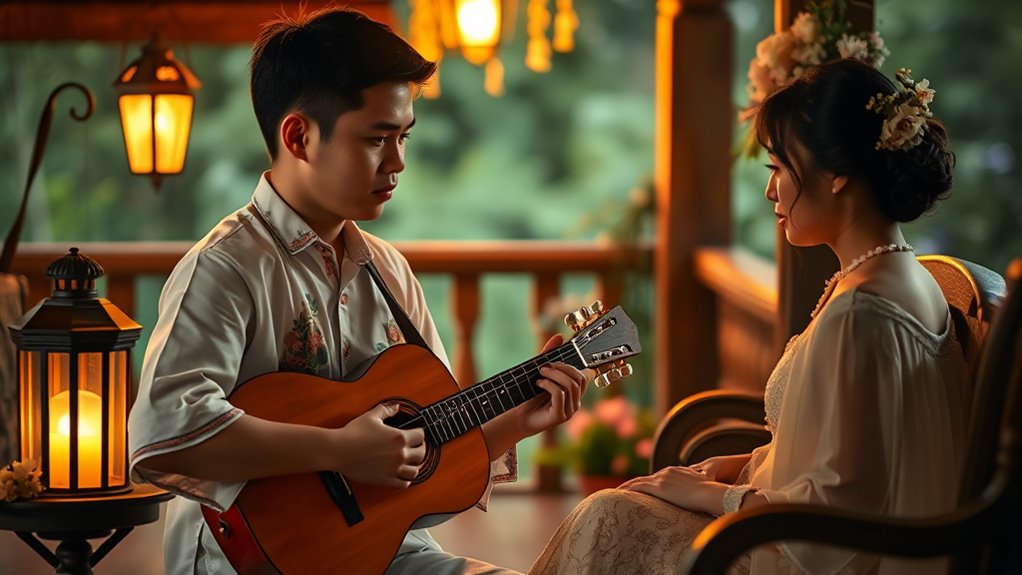Courtship songs like harana classics are more than melodies—they’re powerful cultural expressions of love, respect, and tradition. These songs serve as heartfelt gestures to attract a mate and build connections, embodying emotional and social significance. Over time, they’ve evolved from simple folk tunes to complex performances that blend tradition with modern styles. Exploring this playlist will reveal how these melodies continue to honor cultural heritage while inspiring love across generations. Keep exploring to learn more about their rich history and meaning.
Key Takeaways
- Courtship songs like harana are traditional Filipino melodies used to express love and admiration during courtship rituals.
- These songs embody cultural values, respect, and devotion passed down through generations.
- Harana classics often feature acoustic instruments and poetic lyrics, reflecting historical and emotional significance.
- Modern playlists blend traditional harana with contemporary styles, keeping the cultural heritage relevant today.
- Listening to these melodies connects us to Filipino cultural identity and the deep emotional roots of courtship traditions.

Courtship songs are a fascinating form of communication used by many animals to attract mates and establish territories. These melodies serve more than just biological purposes; they carry cultural significance that often reflects the traditions, values, and histories of human communities. When you listen to courtship songs, you’re not only hearing a musical expression of love or desire but also tapping into a deep-rooted cultural heritage. Throughout history, different societies have developed their own styles of courtship music, shaping their cultural identities and social norms. For instance, in the Philippines, the traditional harana is more than just a song; it’s a ritual that embodies respect, devotion, and a sense of community. Such musical traditions are passed down through generations, maintaining their importance amidst modern influences. They serve as a bridge between the past and present, preserving cultural stories and values that define a community’s identity.
The musical evolution of courtship songs reveals how these melodies adapt over time while retaining their core emotional essence. Originally, these songs were simple, acoustic expressions rooted in folk traditions, often performed in intimate settings. As societies evolved, so did the complexity and style of these compositions. Instruments, arrangements, and lyrical themes became more sophisticated, reflecting changing tastes and social dynamics. Today, you might find contemporary adaptations that blend traditional harana elements with modern genres like pop or acoustic ballads, making them relevant to younger generations. Despite these changes, the fundamental purpose remains unchanged: to communicate affection and admiration in a way that resonates emotionally. The evolution of these songs demonstrates how cultural practices adapt without losing their core significance, evolving alongside the communities they serve. Additionally, understanding cultural traditions related to music enriches our appreciation of their significance beyond mere entertainment.
When you explore courtship songs like the harana, you’re witnessing a rich tapestry of cultural significance intertwined with musical evolution. These songs are more than just melodies—they’re expressions of love, respect, and social connection that have stood the test of time. They remind us that music, especially in the context of courtship, carries deep emotional and cultural weight. Whether performed in traditional settings or modern reinterpretations, these songs continue to symbolize devotion and cultural identity. By understanding their history and evolution, you gain insight into how human interactions, cultural values, and musical expression are deeply interconnected. So, as you listen to these timeless melodies, remember that they embody a shared human experience—one that transcends generations and continues to inspire love and connection through song.
Frequently Asked Questions
How Did Harana Originate Historically?
You’re curious about how harana originated historically. Harana began as a traditional Filipino courtship practice where suitors serenaded their beloveds with heartfelt songs, symbolizing respect and sincerity. Its cultural significance lies in fostering genuine emotional connections. Over time, its historical evolution reflects changing social norms, but the core remains a romantic gesture that celebrates love and devotion through music, preserving a cherished Filipino tradition across generations.
What Are the Typical Instruments Used in Courtship Songs?
You’ll find that traditional instruments like the guitar, ukulele, and bandurria often set the romantic tone in courtship songs. These instruments create a warm, intimate atmosphere, perfect for serenades. Modern adaptations sometimes include acoustic guitars or even keyboards, blending old and new sounds. Whether traditional or contemporary, these instruments help convey emotion and sincerity, making each serenade memorable for both singer and listener.
Are Harana Songs Performed Exclusively in the Philippines?
Think of harana songs as a bridge connecting hearts across generations. While they hold deep cultural significance in the Philippines, you won’t find them performed exclusively there. Regional variations influence their style, but their soulful melodies and romantic gestures resonate widely. You might encounter similar courtship traditions in other cultures, yet harana remains uniquely Filipino, embodying a cherished tradition that’s both local and universal in its expression of love.
How Has Modern Music Influenced Traditional Harana?
You might wonder how modern music influences traditional harana. It’s clear that while contemporary styles bring fresh sounds, they also challenge cultural preservation. You see, musical evolution occurs as artists blend old and new, keeping harana relevant. This fusion helps preserve its essence while embracing change, ensuring that the tradition adapts without fading. In this way, modern music both transforms and sustains the rich cultural heritage of harana.
Can Anyone Learn to Perform Harana Songs Today?
Imagine yourself serenading under a starry sky, voice filled with heartfelt emotion—anyone can learn to perform harana songs today. With dedication, you can embrace cultural preservation and adapt traditional melodies to modern tastes. Musical adaptability makes it accessible, allowing you to carry on this beautiful tradition. Whether you’re a beginner or experienced, passion and practice *uncover* the magic of harana, connecting generations through authentic Filipino courtship songs.
Conclusion
As you listen to these harana classics, you’ll feel the magic of centuries of courtship woven into every note. These songs aren’t just melodies; they’re timeless love stories that have stood the test of time, sweeping hearts away like a tidal wave. So, next time you hear a serenade, remember—you’re experiencing a passion so powerful, it could move mountains and make the stars jealous. Let these songs inspire your own love story today!









